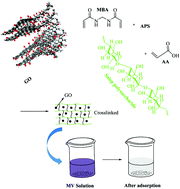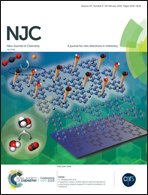Graphene oxide nanocomposite hydrogel based on poly(acrylic acid) grafted onto salep: an adsorbent for the removal of noxious dyes from water†
Abstract
In this study, a graphene oxide nanocomposite hydrogel (GONH) based on poly(acrylic acid) grafted onto a natural salep polysaccharide was synthesized and investigated as an adsorbent for the removal of cationic dye from aqueous solution. The GONH was characterized and the absorption characteristics of the GONH adsorbent were then examined using methyl violet dye. The sorption valence, the effect of the adsorbent dose, pH, contact time, temperature and dye concentration on the removal efficiency of the dye were studied. The assessment of the adsorption isotherms showed that the Langmuir model better fits the experimental data than the Freundlich model and the Ho–McKay kinetic equation better describes the absorption kinetics than the Lagergren equation. Also, the thermodynamic parameters computed from the sorption isotherms indicated a spontaneous absorption process. The GONH is an efficient adsorbent and could be used for separation aqueous solutions.



 Please wait while we load your content...
Please wait while we load your content...